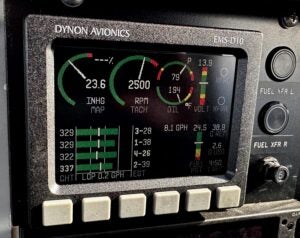Many years ago, after a visit to my snowbird parents, I was IFR and climbing to my eastbound altitude of 9000 feet. We all have mothers, so I shouldn’t have to explain that I had a bag of goodies in the baggage area. I hadn’t looked into it because, well, you don’t turn down anything your mother gives you.

I was just approaching the tops when this unbelievably sharp BANG! went off in the cockpit. It sounded like a shotgun blast. My first thought, of course, was that I had blown a jug clean off the engine. I pitched the nose over, anticipating power loss and decaying airspeed.
As I leveled off, the next thing I did was to scan the engine gauges—all good there. No oil on the windshield and the engine seemed to be running smoothly. All of this took about 5 seconds, though it clearly felt like 50.
Life remained good as I broke out on top. As my heart slowed down I started looking around the cockpit. The baggage area behind the seat had all my usual stuff and the windows were intact. But there was that paper bag from Mom. What exactly was in there? As I peeked in, I saw the cause of my “failure.” A mylar Valentine’s Day balloon—no, not so much a balloon as a flat envelope of foil. Vinyl balloons stretch as the altitude goes up but mylar balloons just build up pressure until they go bang!
I had just relearned a valuable lesson: When you think you have a failure, look for confirming cues to see if it is real. The fact that the engine kept running smoothly made it pretty obvious that I hadn’t blown a jug and the instruments seemed to verify this supposition. It works both ways, though. There are times when your instruments might be lying and you can use “other cues” to verify their readings.

Instrument Trust
What do you do when the instruments tell you one thing yet senses tell you something else? Moreover, trusting an individual instrument is not the same as trusting the picture that all your instruments paint for you. What do you do when the instruments are in conflict—with themselves or with your senses?
The answer, of course, is cross-checking. When learning to fly with instruments, we are taught to cross-check the gauges against one other. If the altimeter is unwinding with the airspeed rising yet the attitude indicator shows us straight and level—something is amiss and it is probably that artificial horizon! If the directional gyro shows us in a turn while the turn-and-bank shows us going straight ahead, as does the compass, you might want to get the bearings in that DG checked. Of course, the ultimate cross-check in VFR conditions is to look out the window.
Other Systems Checks
What about the stuff that tells us how our engine is doing? Can we cross-check that as well?
In the Experimental flight test business, with lots of instrumentation points and fancy telemetry systems, the first thing we teach young engineers is to ask themselves how the data might be lying to them. It pays to fully understand the data-gathering equipment before you rely on it to make decisions. You need to understand that when indications show a failure, you need to use some common sense and realize that anything made by a human being can have flaws. No machine—including the machines that monitor the machines (instrumentation)—is perfect. Therefore we train people to always take just a moment when they see something unusual to ask: How is the instrumentation lying to me? Is what I am seeing real?
This is where the old adage comes from: “When you see something wrong, the first thing to do is wind the clock.” Old-fashioned wind-up panel clocks had a knob on them (I know, I am dating myself) and you could calmly reflect for a few seconds while turning that knob. It gave you a moment to not do the wrong thing. It is a rare situation where you can’t afford to take a few seconds to reflect before taking action.
A classic example would be a tachometer failure. Let’s say that you’re flying along, straight and level, the engine running smoothly—and the tach starts dancing about. You see wild rpm variations, some well above redline. What’s the first thing you should do—pull back on the throttle? Well, eventually that might be a good idea. But before taking that step, how about using your ears? Does it sound like the engine is varying speed? It’s pretty easy to tell by sound that nothing is changing. If the tach is showing fluctuations it must be out to lunch, don’t you think? Now the next question, of course, is what do you do about it. Land immediately? You can do that if you like but if the engine is running fine, you have plenty of gas and nothing else has changed, how about continuing on to your destination or at least a good place where you know that you can get the tach replaced?
Let’s take a look at something a little more serious—oil pressure. You can’t hear oil pressure and the only way to tell if you really have it is via some sort of gauge or pressure switch. Most certified aircraft simply have a gauge—a single source of data. Those with advanced avionics might have software that reads the pressure and if it falls below a preset limit will turn on a light to get your attention. But in the Experimental world, you can add anything you want—and a very simple pressure switch is an easy addition. Wire this up to a light in the cockpit, and you now have the ability to independently confirm or deny the information given to you by the pressure gauge.
Yes, I can hear you saying that a man with two watches never knows what time it is! Well, this is true in principle, but if the man knows that it is daytime and one watch says it is noon while the other says it is 3 a.m., he has a way to pick between the two. Likewise, if your engine has been running fine, and the oil pressure light comes on—the pilot can check the gauge to see if it has changed. Unless you have had two independent, dissimilar yet simultaneous failures, it is quite likely that the engine’s oil pressure is doing just fine. A quick check of oil temperature should add additional data to tell you if things are heating up from a lack of oil (and oil pressure) or not. While these indications are sometimes slow to manifest, they almost always follow each other. Loss of oil pressure leads to rising oil temperature. (Yes, no oil in the engine can show low temperature but by the time that happens the grinding noises from ahead of the firewall will be a more prominent clue.)
Many years ago, we had no EGT gauges in light airplane cockpits, then we got single-point gauges. We could lean until the needle peaked and that would give us some idea how we were doing toward optimizing fuel flow. Next came all-cylinder gauges with a probe for each exhaust port and we learned that maybe we didn’t know as much as we thought from that single probe and gauge. Unfortunately, some folks have always flown with the all-cylinder EGT systems and have never had to simply have faith in the engine designers who say that for a normally aspirated engine, there is no such thing as too high of an EGT. The pilot sees a temperature and wants a limit—or they see a high value and get worried. For non-turbo engines there is no real limit. Instead, you should be looking for consistency from cylinder to cylinder and from day to day.
We teach flight test engineers some very basic interpretation skills that cover most types of transducer systems. A sudden drop-off (it is reading high, then reading low) is usually an indication of a transducer or instrumentation failure. Most temperatures or pressures simply can’t change that suddenly. A steady decline, however, is a good indication of a trending measurement that might be real—a leak, for instance. If your fuel gauge goes from 30 gallons to zero instantly, you probably didn’t rupture a tank, you probably broke a wire. If, on the other hand, you see a steady decline over time, you might very well have ruptured a hose.
You can (and should) go through the mental exercise of evaluating every measurement you have available to you. Think about what it is really telling you and how the data is gathered. Think about what you can use as an alternate cue to confirm or deny a bad reading. Determine in advance what you need to react to immediately and when you can take the time to “wind the clock”—at least a little bit. And always ask yourself the question, “How is my data lying to me?” It is far more common, in fact, for instrumentation to fail than some of the robust systems we have in our airplanes.
Learn what’s normal in your airplane by observation in flight and by looking at recorded data later. When you get an indication that’s out of the ordinary, first look at corroborating data and relationships before pulling the throttle back and looking for an emergency landing site. Maintain a healthy dose of skepticism toward the data and an attentive ear to the machinery. And, while you’re at it, beware mylar balloons.














Similar event happened on a Cardinal that declared an emergency and landed at our airport. He pulled into the FBO and described the same explosive noise the author of this article did. Our intreped mechanic took his flashlight and opened the side baggage door to begin his inspection. A short time later he returned and told the pilot “I think we can fix you up” in the same easy-going tone he always spoke with. He asked me to bring him the shop vac. Then he showed the pilot the damage. A bag of potato chips had exploded and left crumbs all over the baggage area. It was hard not to snicker but then… I wasn’t the guy flying the airplane at the time. He did just what he should have.